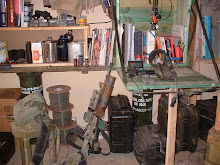The marks are produced when crops growing over buried features develop at a different rate from those growing next to them.
A Roman camp near Bradford Abbas, Dorset, was revealed in June after three sides became visible in rain-parched fields of barley.
The lightly-built defensive enclosure would have provided basic protection for Roman soldiers while on maneuvers in the first century AD and is one of only four discovered in the south west of England.
 An aerial view of a Roman fort dating back 2,000 years was found in North Yorkshire, above. 'Cropmark sites' occur when when crops growing over buried features develop at a different rate from those growing next to them
An aerial view of a Roman fort dating back 2,000 years was found in North Yorkshire, above. 'Cropmark sites' occur when when crops growing over buried features develop at a different rate from those growing next to themDry conditions allowed sites to be photographed in greater detail. Newton Kyme in North Yorkshire, was shown to not only be home to a Roman fort dating back 2,000 years but also a larger, stronger defense built in 290AD; stone walls up to three meters thick and a ditch 15 meters wide were revealed.
Dave MacLeod, an English Heritage senior investigator based in York, said: "It's hard to remember a better year."
 The stone walls of a Roman fort dating back 2,000 years can clearly be seen through crops in Newton Kyme in North Yorkshire. The images were taken by English Heritage from a Cessna light aircraft
The stone walls of a Roman fort dating back 2,000 years can clearly be seen through crops in Newton Kyme in North Yorkshire. The images were taken by English Heritage from a Cessna light aircraftCropmarks are always at their best in dry weather. "This year we have taken full advantage of the conditions. We try to concentrate on areas that in an average year don't produce much archaeology.
"Sorties to the West Midlands and Cumbria, together with more local areas such as the Yorkshire Wolds and Vale of York, have all been very rewarding."
Flights over the Holderness area of the East Riding proved particularly productive with around 60 new sites, mainly prehistoric, found in just one day including livestock and settlement enclosures.
 Researchers hope to discover new sites after examining the photographs taken this summer. This image shows a 'lost' beach where the Romans landed 2,000 years ago to begin their invasion of Britain. Found two years ago, the remains of the shingle harbor were buried beneath 6ft of soil nearly two miles inland from the modern Kent coast.
Researchers hope to discover new sites after examining the photographs taken this summer. This image shows a 'lost' beach where the Romans landed 2,000 years ago to begin their invasion of Britain. Found two years ago, the remains of the shingle harbor were buried beneath 6ft of soil nearly two miles inland from the modern Kent coast.Some sites which have not been visible since the drought of 1976 reappeared this summer.
Damian Grady, a Swindon-based English Heritage senior investigator, said: "Promising signs started to emerge in late May when the dry conditions had started to reveal cropmarks on well drained soils, especially river gravels and chalk in the east and south east of England.
"By June it became clear that the continuing dry conditions would produce good results across most of the country.
"We then targeted areas that do not always produce cropmarks, such as clay soils, or have seen little reconnaissance in recent years due to recent wet summers or busy airspace.
"Unfortunately July saw deterioration in the weather which reduced the amount of flying we could do and the cropmarks started to disappear just before the harvest got under way."
Mr Grady added: "It will take some time to take stock of all the sites we have photographed, but we expect to discover several hundred new sites across England."
The ash cloud grounded all planes except the Cessna
Damian Grady, English Heritage Senior Investigator based in Swindon, said: “This year’s summer got off to an unusual start when the Icelandic ash cloud closed down a lot of airspace to jet aircraft. Fortunately the piston-powered Cessnas used by aerial archaeologists were not affected by the ash, so it was easier to undertake planned flights inside airspace around Gatwick, Stansted, Luton and Bristol airports."
Source: English Heritage

.












































No comments:
Post a Comment